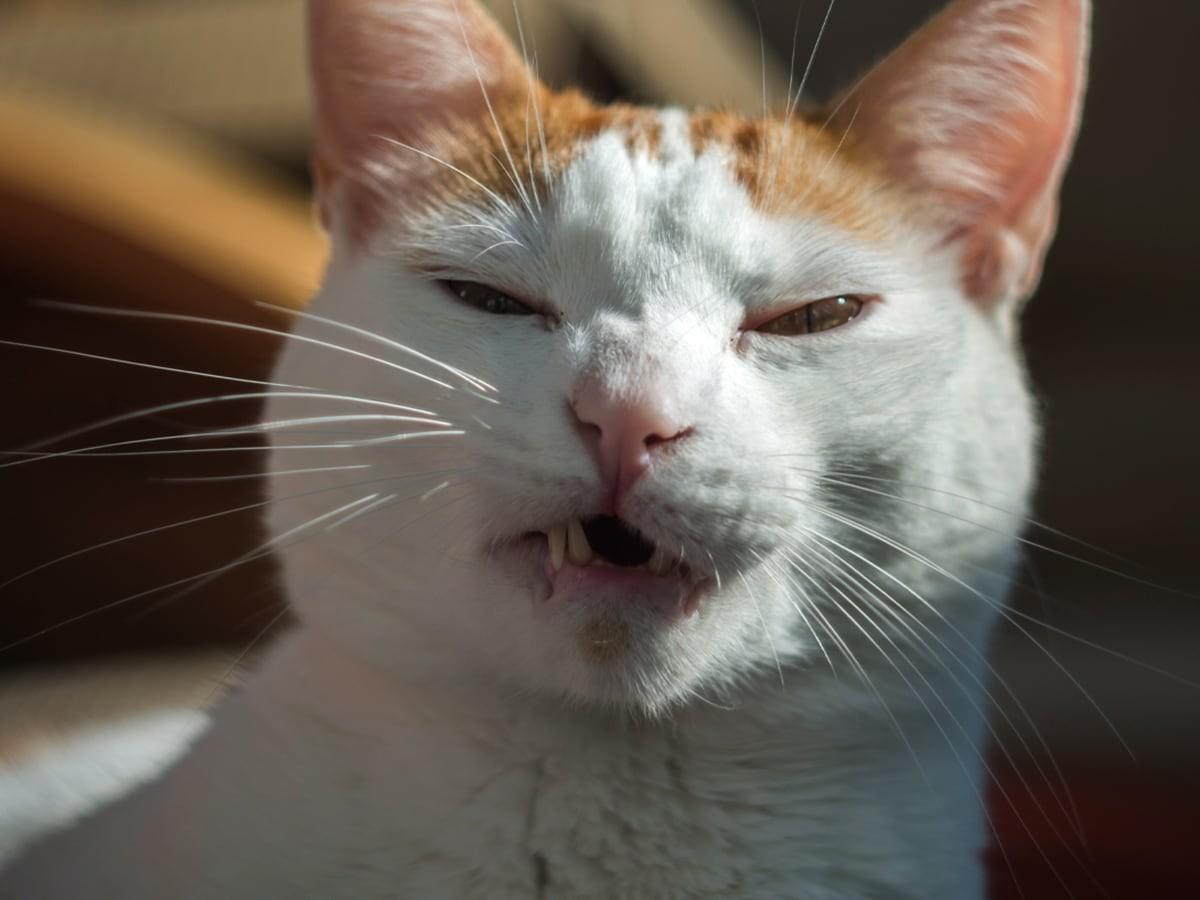Bless you! Gesundheit! Salud! Did your cat just sneeze again?
It’s usually nothing to worry about. Just like you, cats sneeze to clear their airways a few times each day. However, if your cats are sneezing too often, it could indicate an underlying health condition.
How can you tell a normal sneeze from a problematic one? How do you help your sneezing cats? Read on because Spot Pet Insurance is sharing all the details below.
What are the reasons why a cat sneezes?
Cats usually sneeze to flush their airway. Normally, you’ll be saying bless you to your cats a few times a day. It’s usually not a big concern.
On the contrary, if your cats have been sneezing non-stop, there may be other reasons behind it. Your veterinarian may help identify and take care of your cat’s symptoms.
Here are the reasons why cats sneeze:
Clear airways
Particles find a way into your cat’s nostrils a few times a day. The trigger could be anything in the air, such as dust, pollen, litter, or smoke. They irritate your cat’s airways triggering the sneeze reflex. This sends air rushing out of the respiratory tract to clear the particles.
It’s a natural protective response and doesn’t happen more than a few times a day. Also, in this case, your cat likely won’t have any other symptoms. A vet visit is essential if your cat sneezes too frequently or shows signs of illness such as fever or unusual discharge.
Respiratory infections
When flu hits, you sneeze frequently and struggle with a runny nose. It’s the same for cats, who can get upper respiratory tract infections, including feline influenza.
Cats with the flu may be sneezing for several hours or days. Such sneezing may produce unusual discharge (yellow, green, or bloody) from their nose and eyes. Your cat’s appetite drops, and you might notice they don’t finish their usual food portions.
These symptoms may last anywhere between one week to three weeks. Most cats have these symptoms for more than ten days. Young and elderly cats are often most susceptible to respiratory infections. Any health condition that affects your cat’s immunity also increases the chances of getting the flu.
Viruses
Viral infections can trigger sneezing in your cats. Feline Immunodeficiency Virus (FIV), the cat version of HIV, is one of those viruses. Like the human version of the virus, it depresses your cat’s immune system.
A cat with FIV has a depressed capacity to fight infections. Consequently, they’re open to catching respiratory infections more frequently, hence the sneezing. FIV-positive cats are also at risk for other health conditions.
Cats can also get herpes. And like humans with herpes, cats must manage it their entire lives. There’s no need to worry about catching herpes from your cat because it’s not the same as the human variant.
Flare-ups can occur routinely, especially if your cat encounters triggers such as stress and other illnesses. One sign that your cat might have during flare-ups is sneezing.
Other infections that may cause your cat to sneeze often include calicivirus, mycoplasma, and chlamydia.
Foreign object inhalation
Cats can sometimes inhale foreign objects that can block their airway. It’s not too frequent, but it happens. This obstructs nasal passages and makes breathing uncomfortable and difficult.
In a bid to eliminate the obstruction, your cat may try sneezing. Cats will likely keep doing this till they successfully dislodge the object. If your cat sneezes too often, peek into their airway. If you see something in your pet’s throat, take them to the vet without delay.
Dental disease
Cats can get dental diseases such as tooth resorption, gingivitis, and periodontitis. These conditions can be pretty painful and negatively affect your pet’s quality of life. If their teeth get bad enough, your cat may stop eating.
Other unpleasant symptoms of feline dental disease are excessive sneezing, bleeding gums, and tooth loss. Check your cat’s gums for signs of dental disease such as redness, inflammation, bleeding, and bad breath.
A visit to your vet is necessary. Treating your cat’s dental disease begins with diagnosis, which involves X-rays and dental exams.
Allergies
Although it’s not very common, cats can get allergies like humans.
The classic signs of allergies in cats include:
lesions
itchiness
hair loss
Diarrhea
Vomiting
Difficulty breathing
Although sneezing isn’t a typical sign of cat allergies, you shouldn’t rule it out. Even very traditionally healthy cats, like the Russian blue cat, could be troubled by allergy triggers inside and outside your home. Pollen, mold, and dust may activate your cat’s allergies.
Nasal tumors
Nasal tumors can be hidden away in a cat’s nasal cavity or nasal sinuses. It forms about one percent of cat tumors, so it’s pretty rare. As a result, finding it early on can be challenging.
Knowing the signs of nasal tumors is crucial. You can report to your vet for a full-body workup to figure out what’s wrong.
The symptoms of feline nasal tumors include:
Excessive sneezing
Loud snoring
Bloody nose
Facial deformity
Nasal discharge
Seizures
Sneezing alone isn’t enough to have you worried about your cat having nasal tumors. Consequently, you can check it out with your vet to ensure that your cat is in perfect health. Diagnosing nasal cancers may involve physical exams, tissue biopsy, blood tests, radiography, and rhinoscopy.
How do you help your sneezing cat?
Your cat is sneezing excessively, so what do you do?
Here are tips to help reduce your cat’s sneezing and help your furry friend feel more comfortable:
Remove the irritant
Try to identify what triggers your cat’s sneezing. For instance, if dust makes your cat sneeze often, try switching to wet dusting. Wet dusting reduces how much dust gets in the air.
You may also reduce chemical irritants such as perfume and cleaning products. Try the unscented varieties or switch to a less triggering fragrance.
Humidifier
Dry air will only aggravate your cat’s symptoms. A humidifier infuses moisture back into the air. This helps with reducing congestion and inflammation so that your cat feels better.
Nasal sprays
Confirm with your vet that it’s okay to use nasal sprays for your cat. If sneezing is related to dryness or congestion, this might help.
When to see your vet
If your cat’s sneezing won’t let up after a few days, it’s time to involve your vet. Check for other signs too that could be pointing toward other health conditions such as:
Blood
Fever
Lethargy
Drooling
Diarrhea
Wheezing
Depression
Difficulty eating
Reduced appetite
Trouble breathing
Excessive discharge (may be yellow or green)
If your cat isn’t eating anymore, don’t delay that visit to the vet. Cats can’t stay too long without food, and not eating food for two to three days pushes their body into starvation mode. This is dangerous because it can affect the liver.
Once your vet identifies what’s making your cat sneeze, they can provide the necessary treatment, which should help your cat feel better.
Feel better soon
Cats sneeze every so often to clear irritants in their nose. On the other hand, if it’s happening too often, it’s troubling.
Health conditions that may make your cat sneeze include:
Allergies
Viral infections
Respiratory infections
Nasal tumors
Dental diseases
Foreign body inhalation
Check with your vet to identify why your cat is sneezing for immediate treatment. You can help them feel more comfortable by removing irritants from their environment, using a humidifier, or nasal sprays.

Mostly a tech person, always a pet person. I am dedicated to improving the lives of pets and their humans with technology. Off-duty, I enjoy writing about the misbehaving of computer programs and my two Aussiedoodles, Calvin and Hobbes.
7 Causes of Cat Sneezing | Pet Health Network
Cat Sneezing: Causes and When it’s a Concern | Caring Hearts Animal Hospital
Feline Dental Disease | Cornell University College of Veterinary Medicine
Allergies in Cats | The Spruce Pets
Learn About Nasal Cancer in Cats | PetCure Oncology
Influenza in Cats | Seasonal Influenza (Flu) | CDC












